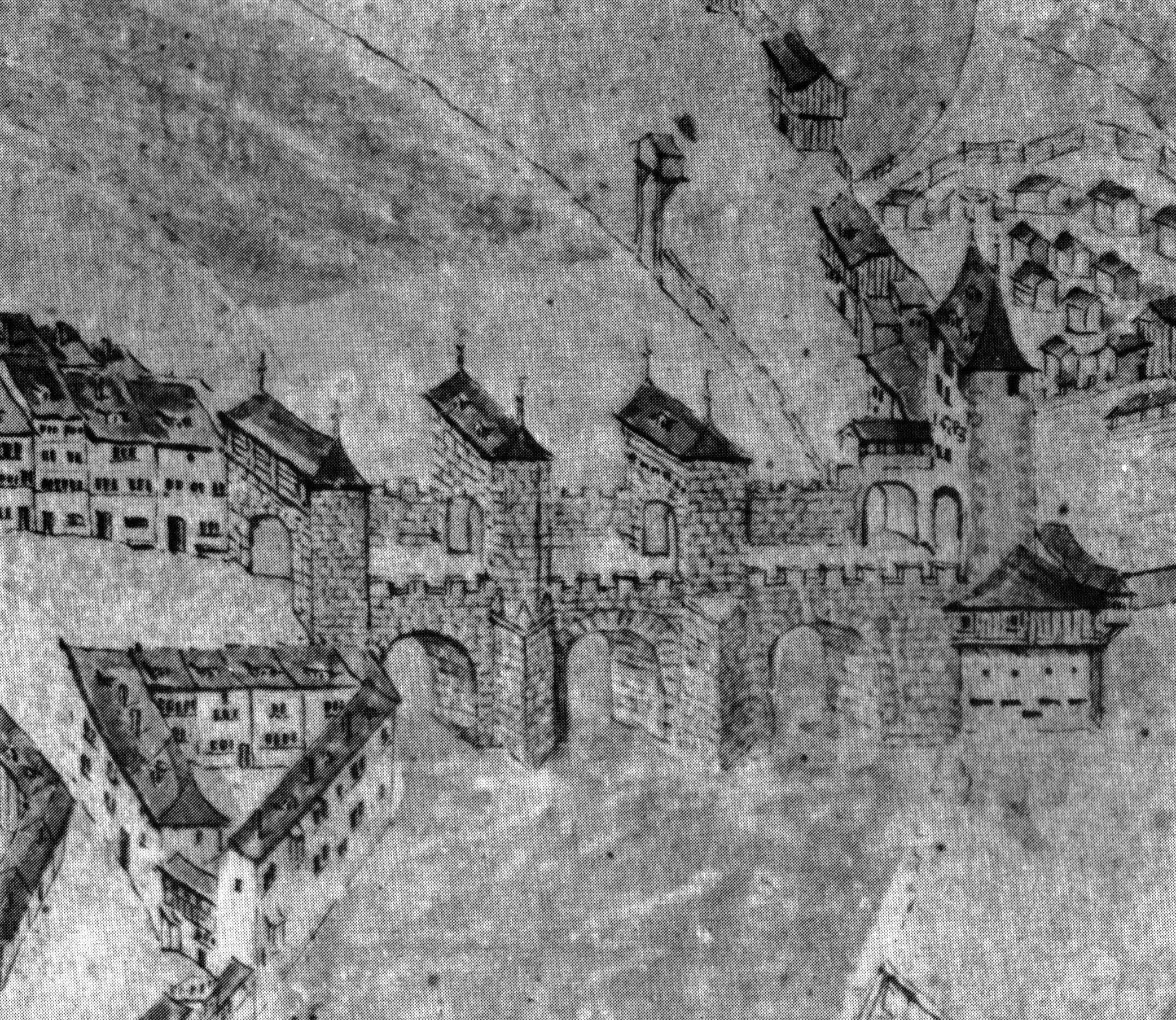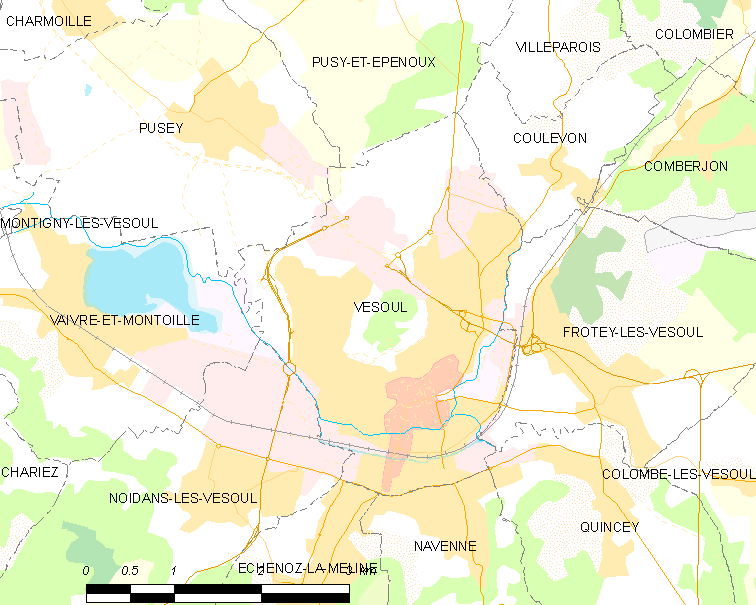|
Käfigturm
The Käfigturm is a Baroque tower in Bern, Switzerland. It is part of the UNESCO Cultural World Heritage Site of the Old City of Bern and the tower is a Cultural Property of National Significance. The original tower was built as a gate house during the second expansion of Bern in 1256. The tower was demolished in 1640 and completely rebuilt immediately thereafter. History The first tower, which stood on the site of the present Käfigturm, was built in 1256 during the second expansion of Bern. Over the nearly seventy years since the construction of the Zytglogge tower and the first city walls, Bern had expanded westward along the Aare peninsula. In 1255, construction began on a second set of walls, which required a new gatehouse. The new tower was very similar to the original Zytglogge. It was built as a hollow square and most of the back of the tower was open to the city. It had a small, flat platform at the top and a gate that opened onto the bridge over the moat. ... [...More Info...] [...Related Items...] OR: [Wikipedia] [Google] [Baidu] |
Old City (Bern)
The Old City (german: Altstadt) is the medieval city center of Bern, Switzerland. Built on a narrow hill bordered on three sides by the river Aare, its compact layout has remained essentially unchanged since its construction during the twelfth to the fifteenth century. Despite a major fire in 1405, after which much of the city was rebuilt in sandstone, and substantial construction efforts in the eighteenth century, Bern's old city has retained its medieval character. The Old City is home to Switzerland's tallest minster as well as other churches, bridges and a large collection of Renaissance fountains. In addition to many historical buildings, the seats of the federal, cantonal and municipal government are also situated in the Old City. It is a UNESCO Cultural World Heritage Site since 1983 due to the compact and generally intact medieval core and is an excellent example of incorporating the modern world into a medieval city. Numerous buildings in the Old City have been designat ... [...More Info...] [...Related Items...] OR: [Wikipedia] [Google] [Baidu] |
Old City Of Bern
The Old City (german: Altstadt) is the medieval city center of Bern, Switzerland. Built on a narrow hill bordered on three sides by the river Aare, its compact layout has remained essentially unchanged since its construction during the twelfth to the fifteenth century. Despite a major fire in 1405, after which much of the city was rebuilt in sandstone, and substantial construction efforts in the eighteenth century, Bern's old city has retained its medieval character. The Old City is home to Switzerland's tallest minster as well as other churches, bridges and a large collection of Renaissance fountains. In addition to many historical buildings, the seats of the Swiss federal government, federal, Canton of Bern, cantonal and municipal government are also situated in the Old City. It is a UNESCO Cultural World Heritage Site since 1983 due to the compact and generally intact medieval core and is an excellent example of incorporating the modern world into a medieval city. Numerous bu ... [...More Info...] [...Related Items...] OR: [Wikipedia] [Google] [Baidu] |
Bern
german: Berner(in)french: Bernois(e) it, bernese , neighboring_municipalities = Bremgarten bei Bern, Frauenkappelen, Ittigen, Kirchlindach, Köniz, Mühleberg, Muri bei Bern, Neuenegg, Ostermundigen, Wohlen bei Bern, Zollikofen , website = www.bern.ch Bern () or Berne; in other Swiss languages, gsw, Bärn ; frp, Bèrna ; it, Berna ; rm, Berna is the ''de facto'' capital of Switzerland, referred to as the "federal city" (in german: Bundesstadt, link=no, french: ville fédérale, link=no, it, città federale, link=no, and rm, citad federala, link=no). According to the Swiss constitution, the Swiss Confederation intentionally has no "capital", but Bern has governmental institutions such as the Federal Assembly and Federal Council. However, the Federal Supreme Court is in Lausanne, the Federal Criminal Court is in Bellinzona and the Federal Administrative Court and the Federal Patent Court are in St. Gallen, exemplifying the federal nature of the Confederation. ... [...More Info...] [...Related Items...] OR: [Wikipedia] [Google] [Baidu] |
Zytglogge
The Zytglogge (Bernese German: ; ) is a landmark medieval tower in Bern, Switzerland. Built in the early 13th century, it has served the city as guard tower, prison, clock tower, centre of urban life and civic memorial. Despite the many redecorations and renovations it has undergone in its 800 years of existence, the Zytglogge is one of Bern's most recognisable symbols and the oldest monument of the city, and with its 15th-century astronomical clock, a major tourist attraction. It is a heritage site of national significance, and part of the Old City of Bern, a UNESCO World Cultural Heritage site. History When it was built around 1218–1220,Bellwald (1983), 2. the Zytglogge served as the gate tower of Bern's western fortifications. These were erected after the city's first westward expansion following its ''de facto'' independence from the Empire. At that time, the Zytglogge was a squat building of only in height. When the rapid growth of the city and the further expan ... [...More Info...] [...Related Items...] OR: [Wikipedia] [Google] [Baidu] |
Waisenhausplatz
The Waisenhausplatz (Orphanage Plaza) is a plaza in the Old City of Bern, the medieval city center of Bern, Switzerland. It is on the edge of the Innere Neustadt which was built during the second expansion from 1255 to 1260, though the plaza was not built until later. It is on the north of the peninsula, and divided from Bärenplatz by Marktgasse. It is part of the UNESCO Cultural World Heritage Site that encompasses the Old City. History Waisenhausplatz was first used to describe three formerly separate plazas in the 19th century. The southern portion (Nr. 2-14) was built over the ditch in front of the second city wall in the 16th century. Originally known as ''Viehmarkt'' (Cattle Market), then ''Holzmarkt'' (Wood Market), later as ''Weinplatz'' (Wine Plaza) and finally in the 18th and 19th centuries as ''Schweinemarkt'' (Pork Market). The middle section of Waisenhausplatz (Nr. 16-28) was also built over the protective ditch, the ''Tachnaglergraben'', and was known ... [...More Info...] [...Related Items...] OR: [Wikipedia] [Google] [Baidu] |
Gregorius Sickinger
Gregorius Sickinger (1558–1631) was a Swiss painter, draughtsman, and engraver. Sickinger was born in Solothurn. He had 5 brothers and sisters, and was re-married after the death of his first wife. Sickinger worked primarily with woodcuts often used in book illustrations. He died penniless in 1631. There is a Gregor Sickinger street in Fribourg , neighboring_municipalities= Düdingen, Givisiez, Granges-Paccot, Marly, Pierrafortscha, Sankt Ursen, Tafers, Villars-sur-Glâne , twintowns = Rueil-Malmaison (France) , website = www.ville-fribourg.ch , Location of , Location of () () ... in his honour. References *''This article was initially translated from the German Wikipedia.'' 16th-century Swiss painters Swiss male painters 17th-century Swiss painters 1558 births 1631 deaths People from Solothurn {{Switzerland-painter-stub ... [...More Info...] [...Related Items...] OR: [Wikipedia] [Google] [Baidu] |
Tourist Attractions In Bern
Tourism is travel for pleasure or business; also the theory and practice of touring (other), touring, the business of attracting, accommodating, and entertaining tourists, and the business of operating tour (other), tours. The World Tourism Organization defines tourism more generally, in terms which go "beyond the common perception of tourism as being limited to holiday activity only", as people "travelling to and staying in places outside their usual environment for not more than one consecutive year for leisure and not less than 24 hours, business and other purposes". Tourism can be Domestic tourism, domestic (within the traveller's own country) or International tourism, international, and international tourism has both incoming and outgoing implications on a country's balance of payments. Tourism numbers declined as a result of a strong economic slowdown (the late-2000s recession) between the second half of 2008 and the end of 2009, and in consequence of t ... [...More Info...] [...Related Items...] OR: [Wikipedia] [Google] [Baidu] |
Portal (architecture)
A portal is an opening in a wall of a building, gate or fortification, especially a grand entrance to an important structure. Doors, metal gates, or portcullis in the opening can be used to control entry or exit. The surface surrounding the opening may be made of simple building materials or decorated with ornamentation. The elements of a portal can include the voussoir, tympanum, an ornamented mullion or ''trumeau'' between doors, and columns with carvings of saints in the westwork of a church. Examples File:Baroque portal in Brescia.jpg, Baroque portal of a private palace in Brescia File:Dülmen, St.-Viktor-Kirche, Eingangsportal -- 2021 -- 4504-10.jpg, Wooden portal of the Church of St. Victor in Dülmen File:Porto - Sant Martí de Cedofeita - Façana principal.JPG, Romanesque portal of the Church of São Martinho de Cedofeita, with nested arches File:Hronsky Benadik-Hlavny portal klastorneho kostola.jpg, Gothic portal of the church in Hronský Beňadik File:FI-Tampere-20 ... [...More Info...] [...Related Items...] OR: [Wikipedia] [Google] [Baidu] |
Freiburg
Freiburg im Breisgau (; abbreviated as Freiburg i. Br. or Freiburg i. B.; Low Alemannic: ''Friburg im Brisgau''), commonly referred to as Freiburg, is an independent city in Baden-Württemberg, Germany. With a population of about 230,000 (as of 31 December 2018), Freiburg is the fourth-largest city in Baden-Württemberg after Stuttgart, Mannheim, and Karlsruhe. The population of the Freiburg metropolitan area was 656,753 in 2018. In the south-west of the country, it straddles the Dreisam river, at the foot of the Schlossberg. Historically, the city has acted as the hub of the Breisgau region on the western edge of the Black Forest in the Upper Rhine Plain. A famous old German university town, and archiepiscopal seat, Freiburg was incorporated in the early twelfth century and developed into a major commercial, intellectual, and ecclesiastical center of the upper Rhine region. The city is known for its medieval minster and Renaissance university, as well as for its high stand ... [...More Info...] [...Related Items...] OR: [Wikipedia] [Google] [Baidu] |
Vesoul
Vesoul () is a commune in the Haute-Saône department in the region of Bourgogne-Franche-Comté located in eastern France. It is the most populated municipality of the department with inhabitants in 2014. The same year, the Communauté d'agglomération de Vesoul which covers 20 municipalities together had inhabitants while the Urban area of Vesoul which includes 78 municipalities, had inhabitants. Its inhabitants are known in French as ''Vésuliens''. Built on top of the hill of La Motte in the first millennium under the name of ''Castrum Vesulium'', the city gradually evolved into a European commercial and economic center. At the end of the Middle Ages, the city experienced a challenging period beset with plagues, epidemics, and localized conflict. Main urban center of the department, Vesoul is also home to a major PSA parts manufacturing plant and to the Vesoul International Film Festival of Asian Cinema. It was immortalized by Jacques Brel in his 1968 song "Vesoul". ... [...More Info...] [...Related Items...] OR: [Wikipedia] [Google] [Baidu] |
Thirty Years War
The Thirty Years' War was one of the longest and List of wars and anthropogenic disasters by death toll, most destructive conflicts in History of Europe, European history, lasting from 1618 to 1648. Fought primarily in Central Europe, an estimated 4.5 to 8 million soldiers and civilians died as a result of battle, famine, and disease, while some areas of what is now modern Germany experienced population declines of over 50%. Related conflicts include the Eighty Years' War, the War of the Mantuan Succession, the Franco-Spanish War (1635–1659), Franco-Spanish War, and the Portuguese Restoration War. Until the 20th century, historians generally viewed it as a continuation of the religious struggle initiated by the 16th-century Reformation within the Holy Roman Empire. The 1555 Peace of Augsburg attempted to resolve this by dividing the Empire into Lutheranism, Lutheran and Catholic Church, Catholic states, but over the next 50 years the expansion of Protestantism beyond these ... [...More Info...] [...Related Items...] OR: [Wikipedia] [Google] [Baidu] |

.png)





_4029.jpg)
